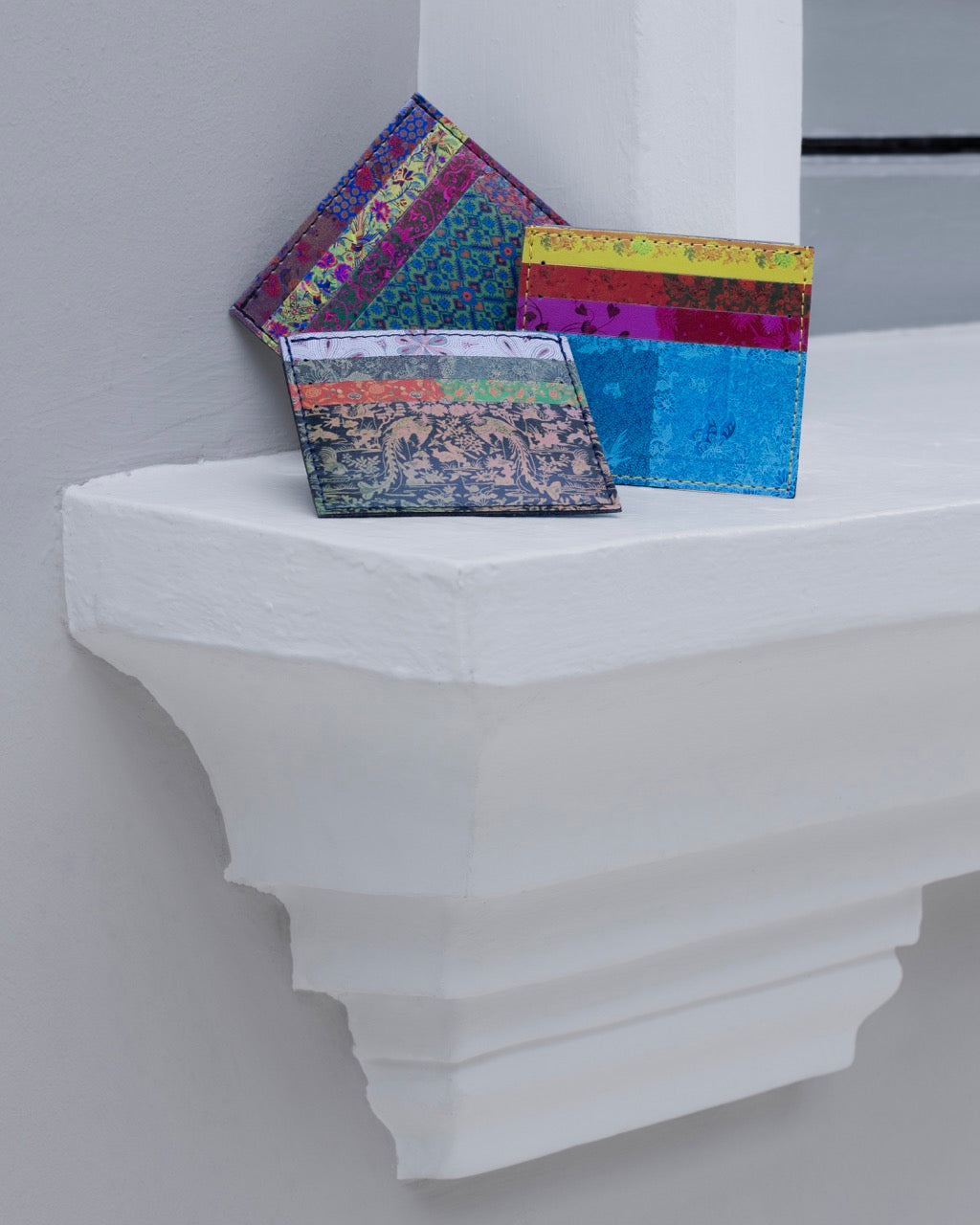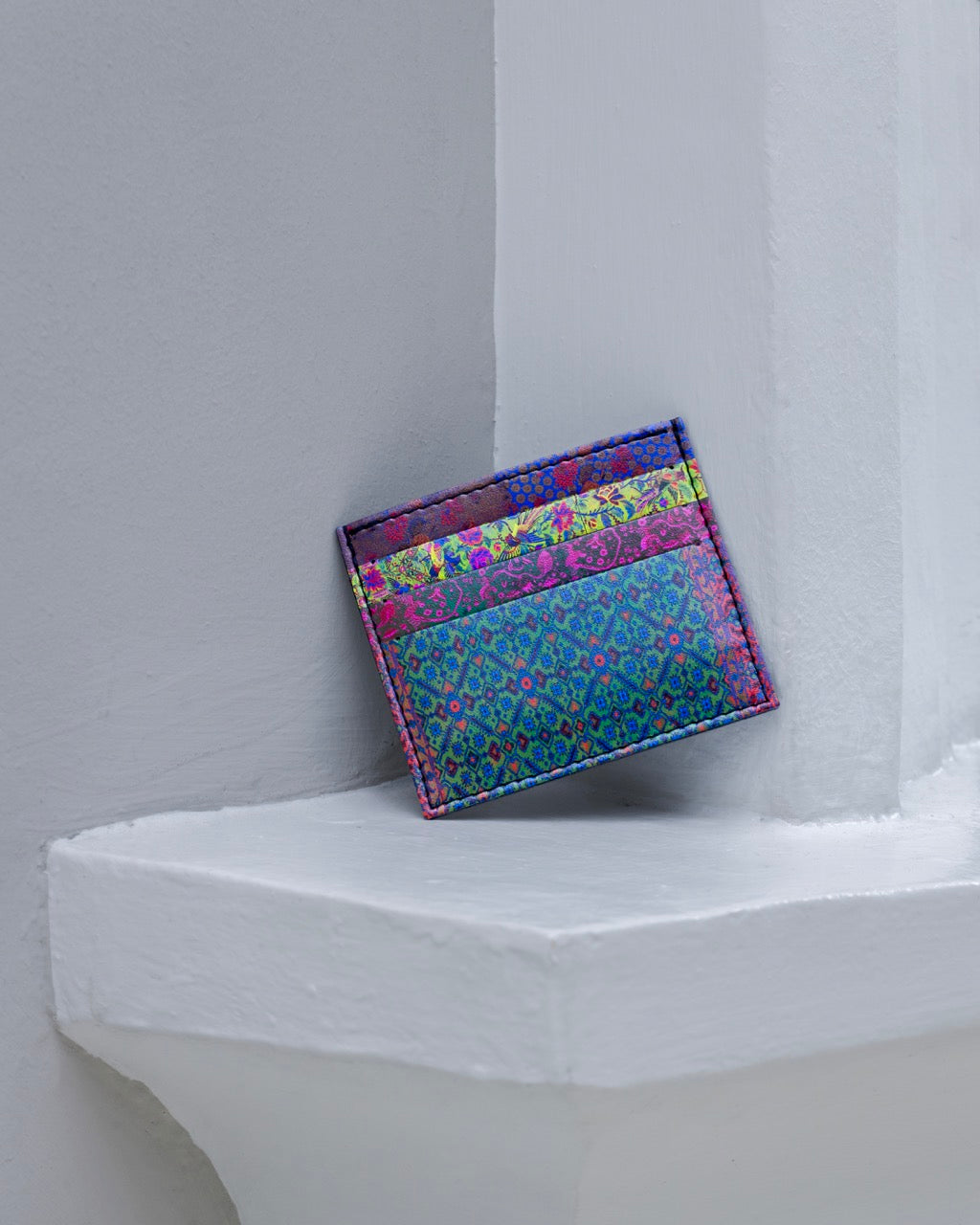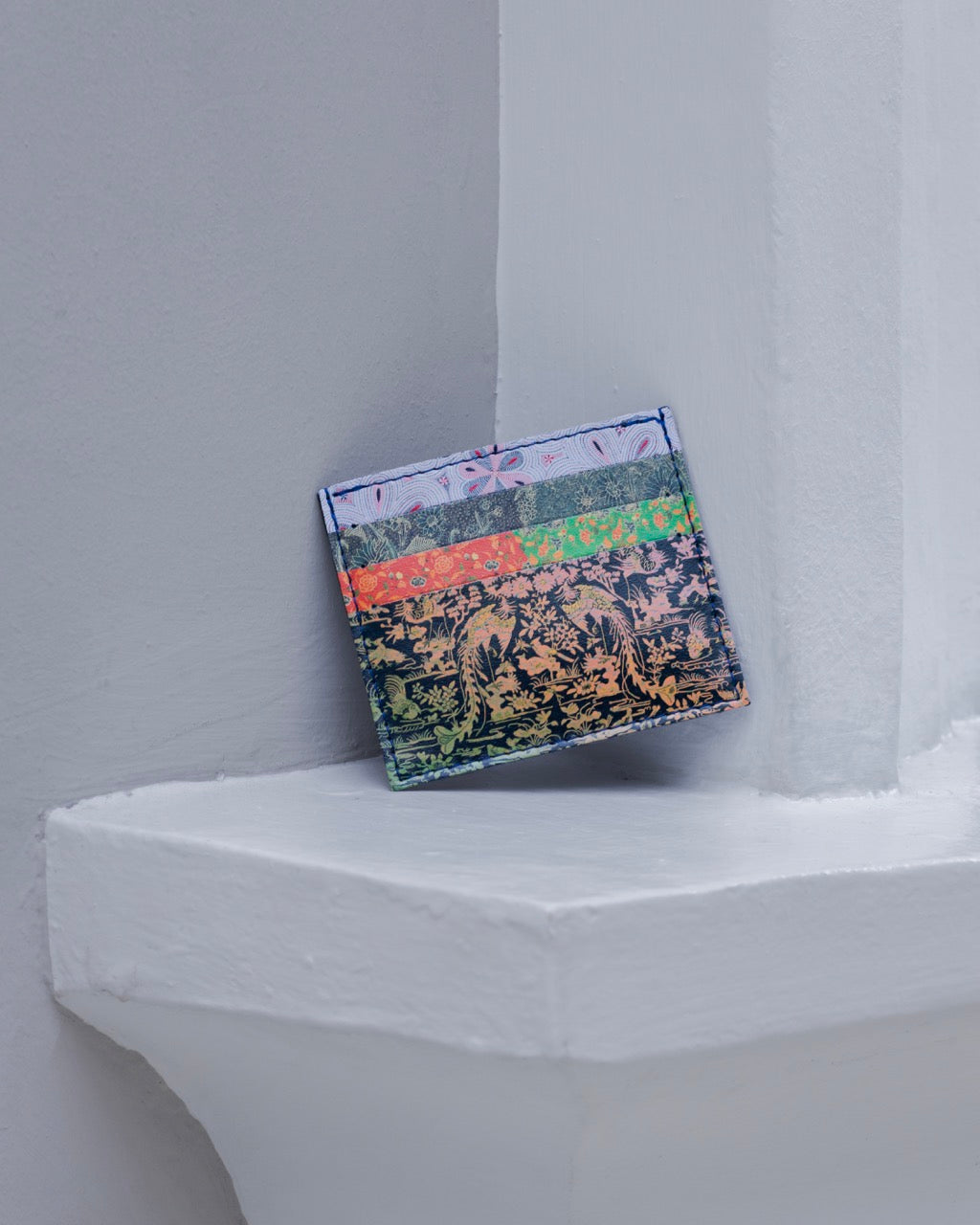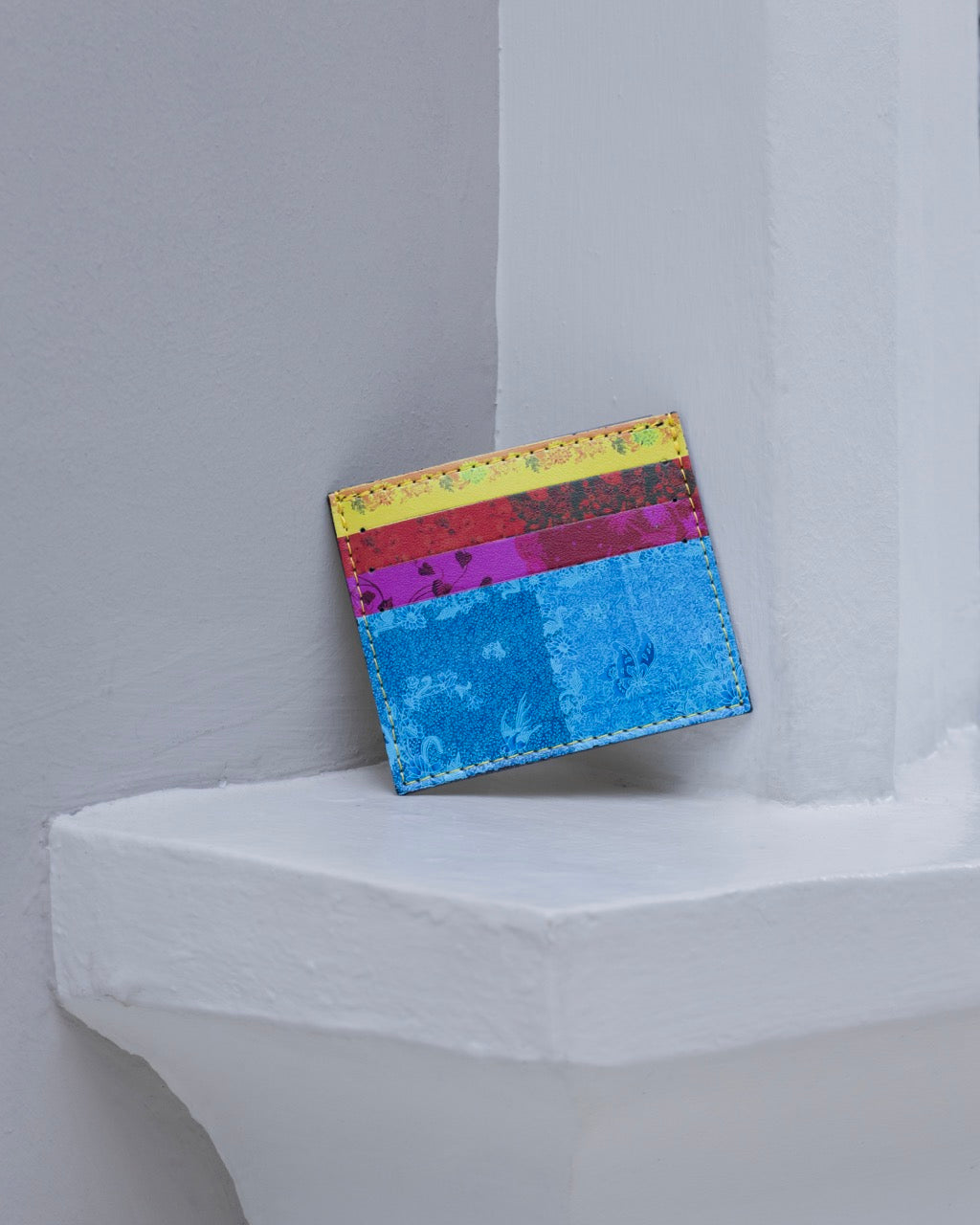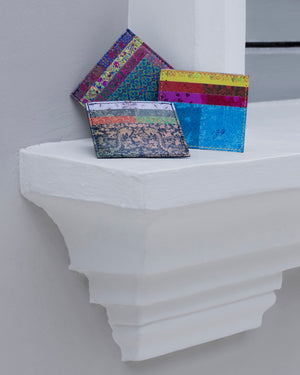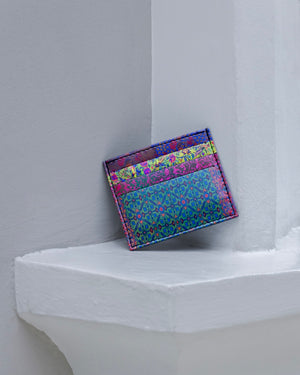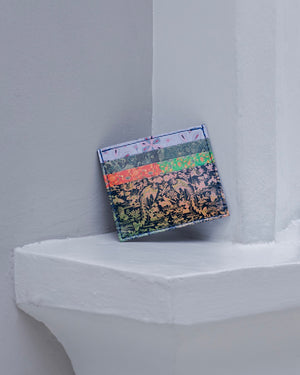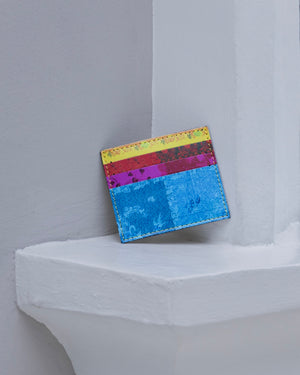NATIONAL COLLECTION X MUSEUM MARTKET CARD HOLDERS
$69.00 SGD
KANTHA EMBROIDERY WITH FLORAL MOTIFS
West Bengal, India, 20th Century Embroidery
Collection of Indian Heritage Centre
2013-00525
Kantha is a form of quilted embroidery skillfully crafted by the women of Bengal, India. These artisans create a range of items, including bedspreads, wraps, and book or mirror covers, intended for domestic use or as thoughtful gifts. Kantha pieces draw inspiration from a diverse array of influences, encompassing rural scenes, city life, modernization, mythological narratives, and the incorporation of floral and vine motifs. Utilizing recycled cloth and yarn sourced from old saris, these intricate works exemplify a harmonious blend of tradition and sustainability. In this example, large floral motifs placed within squares form a repetitive pattern.
SKIRT CLOTH (KAIN PANJANG) THE TIE SIET
Java, Pekalongan, 1930s
Cotton (drawn batik)
Collection of Peranakan Museum
2018-00647
This pink-and-aqua batik kain panjang (skirtcloth) features the pagi-sore (morning-afternoon) format, where two different patterns and colours are divided by a diagonal or straight line at the center. The wearer could choose which side of the design to be visible, according to the time of day and occasion. The batik is signed‚ The TieSiet Pekalongan‚ by the famed Peranakan Pekalongan-based batik-maker. This piece illustrates his characteristic use of bold colours and floral bouquets (peonies and chrysanthemums on each side, respectively), with birds and butterflies flying around them. Peonies are associated with female beauty, and chrysanthemums are associated with longevity and nobility. Peranakan ladies favoured batik skirtcloths made mostly by Chinese and Eurasian batik-makers on the northern coast of Java in towns such as Cirebon, Lasem and Pekalongan.
AN EXOTIC PARSI JHABLA (Child's TUNIC)
Gujarat, India, early 20th century
Textile
Collection of Indian Heritage Centre
2014-00304
The Parsis are Zoroastrians from the province of Pars/Fars in Persia who migrated to India in the 7th century to escape religious persecution. By the 18th century, the Parsis were involved in trade with China, dealing in spices, silk, opium, cotton and tea. Influenced by the aesthetics of the Far East, Parsi traders returned
to India, bringing with them Chinese products such as porcelain and intricately embroidered silks. The unique cultural amalgamation of the Parsis is evident in various aspects of their lifestyle. For instance, they adopted the local Gujarati language, and women traditionally wear the gara sari‚ a South Asian drape adorned with Chinese motifs‚ as testament to the community's involvement in Indo-Chinese trade. For the navjote (the ceremony through which an individual is inducted into the Zoroastrian religion), Parsi children wear a richly embroidered tunic or jhabla. It would be worn with ijar or loose trousers with embroidery at the bottom.
SARONG
Java, 1930s-60s
Textile
Collection of Asian Civilisations Museum
2000-07881
Gift of Anne Soh Gwek Shin
This sarong would have been worn by a nyonya (Peranakan woman) under a kebaya. It features large floral bouquets in the dark blue central panel, over a heavy floral background on the rest of the body. The sombre colours suggest that it was worn during a three-year mourning period. During this time, grandchildren and children of the deceased traditionally wore darker clothing as a sign of respect.
SARONG
Indonesia, late 19th or early 20th century
Cotton (drawn batik)
Collection of Peranakan Museum
2010-01308
Gift of Father Robbie Wowor in memory of grandmother, Mrs. Tan Tjien Sian n Tjoa Soan Tjoe Nio. Manado, Indonesia
The Sarong is a length of cloth that is sewn together at the ends to form a tube. The wearer then steps into the tube and, by folding the excess cloth over itself, tightens the tube into a skirt. Sarongs were commonly made from batik textiles, where plain woven fabric is decorated using molten wax applied or drawn onto the cloth. After successive applications of wax and dye, intricate patterns and designs can be created. This piece is decorated with motifs of peacocks and cranes amidst lotus flowers. Peacocks represent elegance, beauty and dignity, as well as wealth and power. The crane symbolises status and longevity. It is the second most important bird in Chinese legend after the phoenix. Cranes and lotus flowers together show a wish for peace and harmony.
SARONG
Pekalongan, Java, Late 19th or early 20th century
Textile
Collection of Asian Civilisations Museum
1997-04174
Gift of Mr. and Mrs. Andy Ng
This sarong would have been worn by a nyonya (Peranakan woman) under a kebaya. The decoration features large floral bouquets with butterflies and birds. Nyonya-style sarongs are known for their bright and colourful designs in shades of orange, yellow, pink and mauve, made possible by chemical dyes imported from Europe in the 19th century.
SARONG, OEY KOK SING
(KHO TJING NIO, 1896-1966)
Java, Pekalongan, 1940
Cotton (drawn batik), synthetic dyes
Collection of Peranakan Museum
2017-00341
Gift of Ika, Melia, and Inge Hendromartono in memory of their parents Liem Siok Hien and Jane Hendromartono, grandmother Mrs Oey Kok Sing, and great grandmother Mrs Oey Soen King.
Oey Kok Sing was the daughter of Oey Soen King. She embraced the use of synthetic dyes, which were available in Java by the late 19th century.
PATOLA SARI WITH BOHRA GAJJI WEAVE
Gujarat, India, 20th century
Textile
Collection of Indian Heritage Centre
2017-00612
This sari is a fine example of a Bohra Gajji Bhat weave, a distinctive style within the Gujarati Patola tradition. Renowned for their intricate double ikat weaving technique, Patola saris are predominantly crafted by the skilled artisans of the Salvi community in Patan, North Gujarat. The Bohra Gajji Bhat weave, distinguished by its captivating diamond pattern interwoven with rosettes, draws inspiration from the intricate Hindu birth chart, where the positions of planets are believed to influence one's life journey. Notably, this particular sari style has gained immense popularity among members of the Bohra Muslim community residing in Gujarat, reflecting its cultural significance and aesthetic allure.
BED HANGINGS
China, early 20th century
Hangings
Collection of Asian Civilisations Museum
2002-00724
Gift of Mr. Edmond Chin
This pair of bed hangings is ornately designed with floral and phoenix motifs in embroidery and beadwork. It was part of the ensemble of auspicious symbols, especially fertility, which decorated the Peranakan wedding bed. It reflects the hope for many heirs. Wedding beds were one of the largest pieces of furniture in wealthy Peranakan homes, and together with the hangings could be part of the wedding trousseau.
SARONG
Java, Cirebon, 1900-10
Cotton (drawn batik)
Collection of Peranakan Museum
2015-02114
This colour combination of blue and white batik sarong is known as kelengan. The front panel of the sarong is decorated with triangle patterns known as tumpal, with birds like
chickens and phoenixes filling the background of the cloth. Along the borders of the tumpal-filled section of the sarong are fret patterns, a decorative feature commonly found on Chinese ceramics and furniture.
Batik sarongs were worn by Peranakan Chinese in the Strait Settlements and Indonesia as a skirt to accompany a top known as a kebaya.


